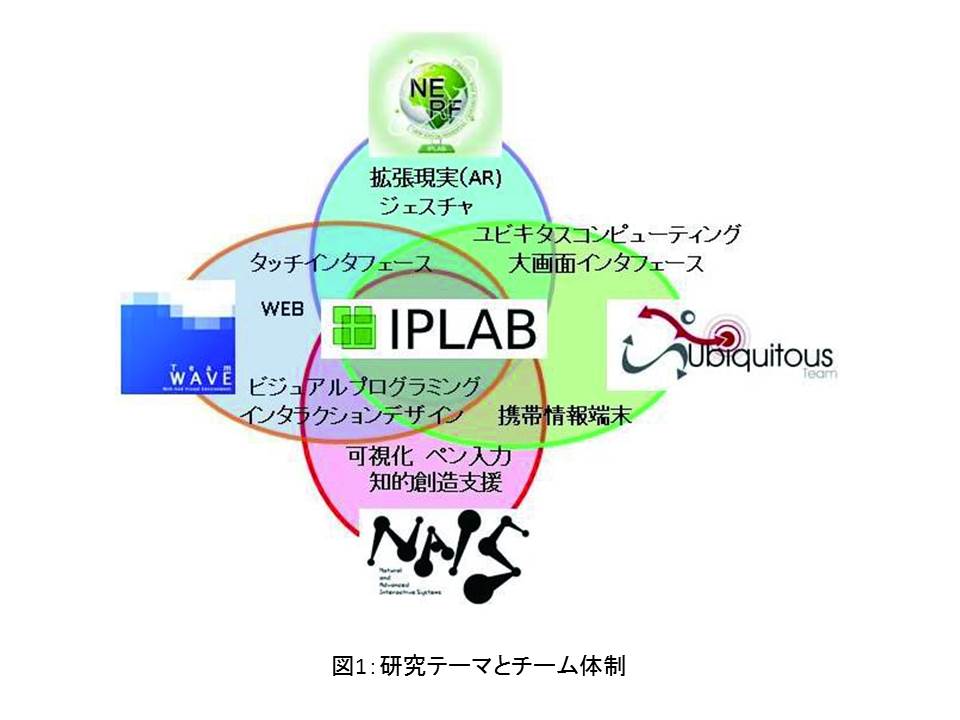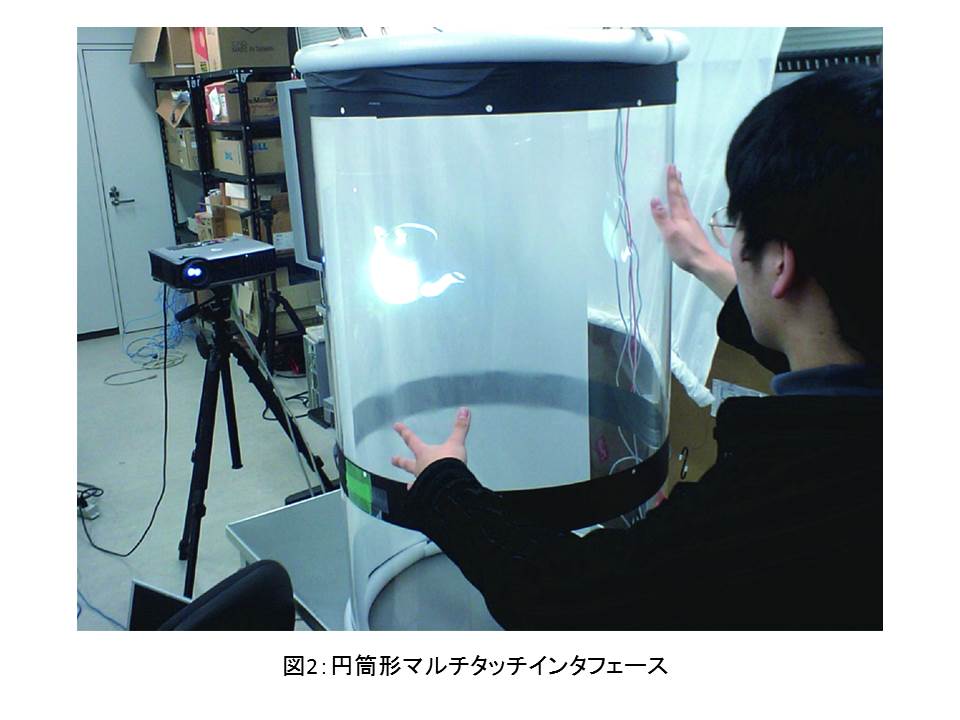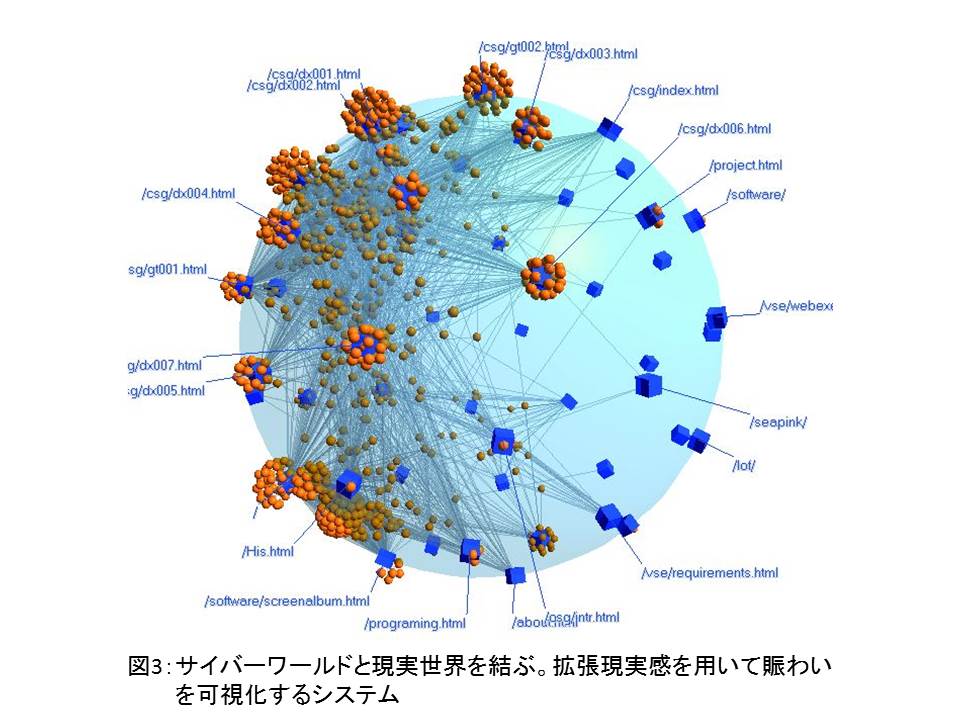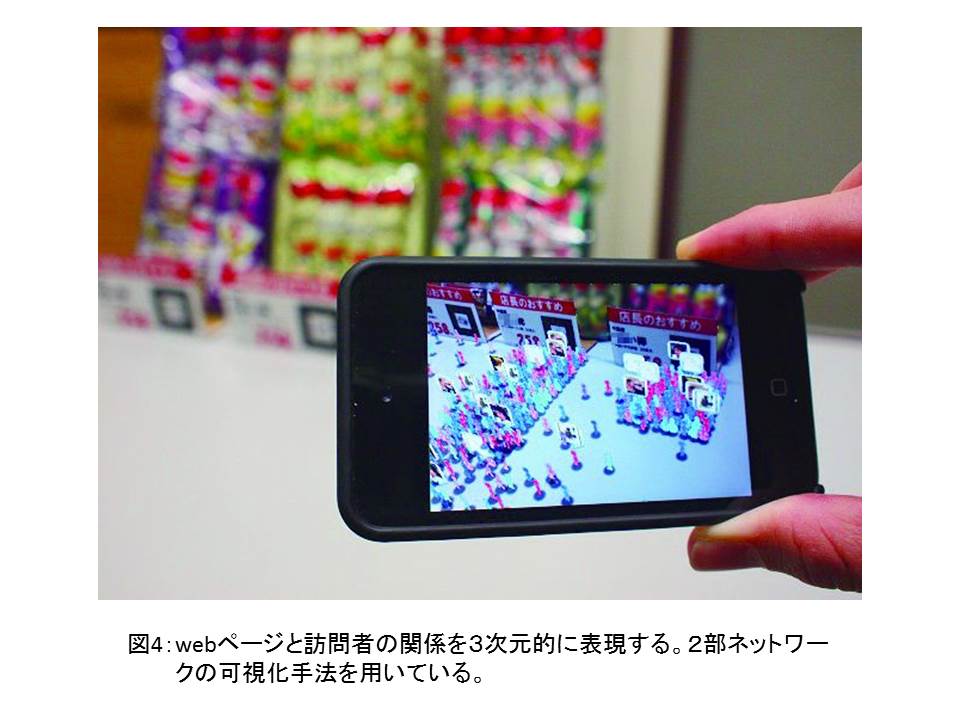キーワード:ユビキタス、ネットワーキングアーキテクチャ、センサー情報処理、ヒューマンインタフェース、セキュア情報処理
 現代の情報社会で目覚ましい発展を遂げているのが情報通信のデバイスです。端末デバイスについても、パソコンからタッチパネル、携帯電話と形態は多岐に渡ります。将来どのように変化していくのでしょうか。本リサーチユニットでは、次世代の情報通信の基盤を確立するために重要な技術を開発しています。中でも鍵となるのは、コンピュータと人間の双方向の対話を可能にするインタラクティブ通信。非常に層の厚い専門家に支えられている筑波大学の情報技術分野が、その知識と技術を結集して様々な技術開発に取り組みます(図1)。
現代の情報社会で目覚ましい発展を遂げているのが情報通信のデバイスです。端末デバイスについても、パソコンからタッチパネル、携帯電話と形態は多岐に渡ります。将来どのように変化していくのでしょうか。本リサーチユニットでは、次世代の情報通信の基盤を確立するために重要な技術を開発しています。中でも鍵となるのは、コンピュータと人間の双方向の対話を可能にするインタラクティブ通信。非常に層の厚い専門家に支えられている筑波大学の情報技術分野が、その知識と技術を結集して様々な技術開発に取り組みます(図1)。

ユーザーにとっての使いやすさや親しみやすさを追求し、次世代の通信基盤を構築する
次世代の情報環境というのはどうなるのかというところを追求し、その発展に必要な技術を研究しています。例えば最近のタッチパネルも今後非常に変わっていくことが予想されます。指で操作するとき音や感触で表示ボタンを押した感覚を持たせたパネルや、複数の指で同時に触って操作するマルチタッチ対応の技術も発展していくでしょう。田中先生の研究室では、円筒形のマルチタッチインタフェースが研究されています。形状が奥行きを持ち、左右に360度連続的であることを活用した独自な操作手法です(図2)。また、様々な情報を分かりやすく表示する(可視化)ための技術の研究にも取り組んでいます(図3)。


サイバーワールドと現実世界をつなげた拡張現実感の実現へ
次世代のデバイスで試されるのは、サイバーワールドという電子的な世界 と物理的な現実世界とをどのように結合するかという問題です。例えば、道に並んでいる商品にスマートフォンをかざすと、その商品の売れ行きや売れ筋、口コ ミなどの情報が表示され、目の前の現実が拡張されて認識できる技術のことを言います(図4)。また、オンラインショッピングで服を買う場合、バーチャルと 現実がなかなか結びつかないことがあります。しかし、ユーザーが服を購入する際に自身のデータや状況に照らし合わせ、状況に合わせて合成した画像を見るこ とができれば、「この会場にこの服は合うだろうか」などと検証することが可能になります。このように、コンピュータとユーザーが対話して拡張現実感を作り 出すことを可能にする、インタラクティブ通信技術の開発を行っています。

社会への貢献・実績
● コンピュータサイエンス分野において、今後重要性が増すと考えられる次世代のインタラクティブ情報通信基盤に関する以下の領域での研究の加速。
● 実環境センサ情報処理 ● インタラクティブ情報通信アーキテクチャ
● ユビキタスソフトウェア ● セキュア社会基盤
(取材:平成25年9月18日)
Toward an era in which everyone uses advanced information-communication technologies
Unit members : Moges Abu Girma Kanazawa Kenji Furukawa, Hiroshi Takahashi, Shin Sannomiya, Shuji Misue, Kazuo Shizuki, Buntarou Shouno, Kazuhiro Ohya, Akihisa
Key words:Ubiquitous, networking architecture, sensor information processing, human-computer interaction, secure information processing
The rapid progress of information-communication devices has been going on. Various forms of information device are currently available, including personal computers, touch-screen tablets, and mobile phones. How will this device change in the future? The research unit develops technologies required to establish infrastructures for next-generation information-communication. The key technology is the  interactive communication that allows computers and humans to interact with each other bi-directionally. The research unit, consisting of leading specialists, is involved in various technological developments by incorporating knowledge and techniques (Figure 1).
interactive communication that allows computers and humans to interact with each other bi-directionally. The research unit, consisting of leading specialists, is involved in various technological developments by incorporating knowledge and techniques (Figure 1).

Figure 1: Research themes and the organization of the team
Development of next-generation communication infrastructures by pursuing user-friendliness
The research unit proposes future-generation information environments, and develops technologies required for their development. For example, touch-screen devices supported by recently-developed technologies are expected to undergo significant changes in the future. When the users of touch-screen devices touch a button displayed on a panel in the near future, they will feel as if they are touching a real button. There will also be a further progress in multi-touch technology in which users can touch multiple places at the same time using two or more fingers to perform a task. The research unit has worked for the research on multi-touch interfaces using cylindrical objects. Unique operating procedures are developed by taking advantage of the depth of the cylindrical object and its 360-degree rotation in the left-right direction (Figure 2). The research unit also conducts research to develop technologies designed to present a variety of information for people to understand easily (Figure 3).

Figure 2: Cylindrical multi-touch interface

Figure 3: The relationship between a website and visitor expressed three-dimensionally
Linking the cyber world to the real one
Next-generation devices are challenged by the issue of how the cyber world and the real world will be integrated. For example, when the users of a smartphone supported by such technologies hold it up toward products on a shelf, information on their sales, the best-selling products, and customers’ responses are displayed on the screen, using augmented reality technology (Figure 4). When purchasing clothes at online stores, it is sometimes difficult to associate online information with real one. However, under the new system, online shoppers will be able to examine whether or not an outfit is appropriate for the occasion by viewing synthetic images created based on their personal data and conditions. The research unit is involved in the development of interactive communication technologies, which allow people to interact with computers utilizing augmented reality technology.

Figure 4: Linking the cyber world to the real one. A system to visualize the level of congestion using augmented reality.
Social contributions and achievements
– Sensor information processing
– Interactive information-communication architecture
– Ubiquitous software
– Infrastructure for a secure society
